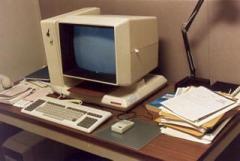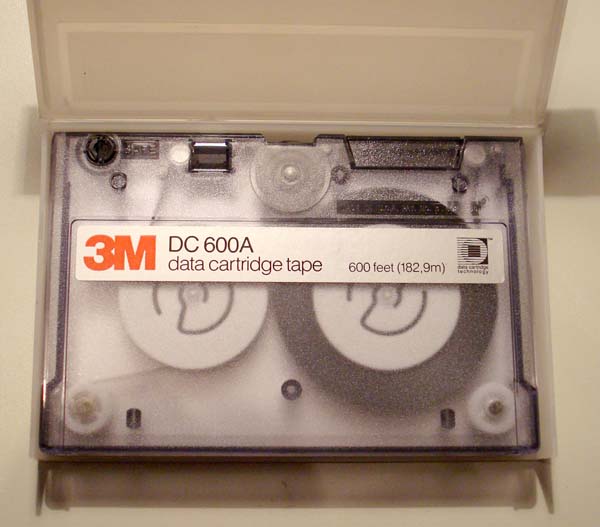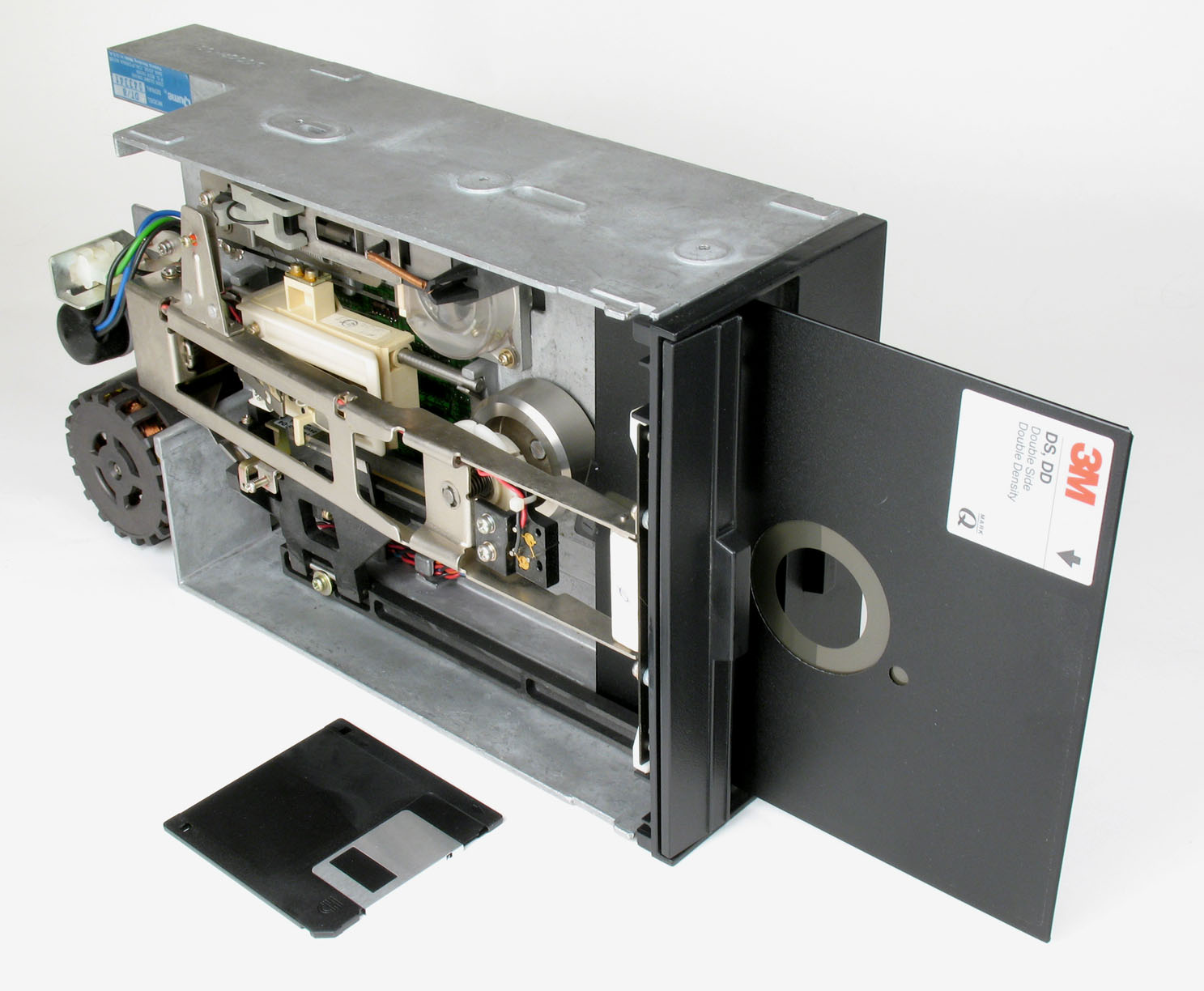 |
Apollo Domain
Apollo/Domain is a series of workstations that were developed and produced by Apollo Computer from to 1989. The machines were built around the Motorola 68k series of processors, except for the DN10000, which has from one to four of Apollo's RISC processors, named PRISM. Operating system The original operating system is Apollo's own product called Aegis, which was later renamed to Domain/OS. The Aegis and Domain/OS system offers advanced features for the time, for example an object oriented filesystem, network transparency, diskless booting, a graphical user interface, and, in Domain/OS, interoperability with BSD, System V, and POSIX. Hardware An Apollo workstation resembles a modern PC, with a base unit, keyboard, mouse, and screen. Early models are housed in short (about 2 feet high) 19" rack cabinets to be set beside a desk or under a table. The DN300 and later DN330 were designed as integrated units with the system and monitor in one unit. These models fit easily on ... [...More Info...] [...Related Items...] OR: [Wikipedia] [Google] [Baidu] [Amazon] |
 |
Workstation
A workstation is a special computer designed for technical or computational science, scientific applications. Intended primarily to be used by a single user, they are commonly connected to a local area network and run multi-user operating systems. The term ''workstation'' has been used loosely to refer to everything from a mainframe computer terminal to a Personal computer, PC connected to a Computer network, network, but the most common form refers to the class of hardware offered by several current and defunct companies such as Sun Microsystems, Silicon Graphics, Apollo Computer, Digital Equipment Corporation, DEC, HP Inc., HP, NeXT, and IBM which powered the 3D computer graphics revolution of the late 1990s. Workstations formerly offered higher performance than mainstream personal computers, especially in Central processing unit, CPU, Graphics processing unit, graphics, memory, and multitasking. Workstations are optimized for the Visualization (graphics), visualization and ma ... [...More Info...] [...Related Items...] OR: [Wikipedia] [Google] [Baidu] [Amazon] |
 |
Motorola 68010
The Motorola MC68010 and Motorola MC68012 are 16/32-bit microprocessor, microprocessors from Motorola, released in 1982 as successors to the Motorola 68000. The 68010 and 68012 added virtualization features, optimized loops and fixed several small flaws to the 68000. The MC68010 variants were Pin compatibility, pin compatible with its predecessor while the MC68012 is an 84-pin pin grid array, PGA version with its directly accessible memory space extended to 2 gigabyte, GiB. Differences between 68010/68012 and 68000 The 68010 and 68012 are completely user-mode compatible with the 68000, except that the MOVE from SR instruction traps in user mode, so that, to support user-mode code using that instruction, a supervisor-mode trap handler must simulate the instruction and continue the user-mode code after that instruction. This was done so that the 68010 and 68012 would meet the Popek and Goldberg virtualization requirements, specifically that a new OS could run as guest and no ... [...More Info...] [...Related Items...] OR: [Wikipedia] [Google] [Baidu] [Amazon] |
 |
Intel 80286
The Intel 80286 (also marketed as the iAPX 286 and often called Intel 286) is a 16-bit microprocessor that was introduced on February 1, 1982. It was the first 8086-based CPU with separate, non- multiplexed address and data buses and also the first with memory management and wide protection abilities. It had a data size of 16 bits, and had an address width of 24 bits, which could address up to 16M of memory with a suitable operating system such as Windows compared to 1M for the 8086. The 80286 used approximately 134,000 transistors in its original nMOS ( HMOS) incarnation and, just like the contemporary 80186, it can correctly execute most software written for the earlier Intel 8086 and 8088 processors. The 80286 was employed for the IBM PC/AT, introduced in 1984, and then widely used in most PC/AT compatible computers until the early 1990s. In 1987, Intel shipped its five-millionth 80286 microprocessor. History and performance Intel's first 80286 chips were specified for ... [...More Info...] [...Related Items...] OR: [Wikipedia] [Google] [Baidu] [Amazon] |
|
Emulator
In computing, an emulator is Computer hardware, hardware or software that enables one computer system (called the ''host'') to behave like another computer system (called the ''guest''). An emulator typically enables the host system to run software or use peripheral devices designed for the guest system. Emulation refers to the ability of a computer program in an electronic device to emulate (or imitate) another program or device. Many printer (computing), printers, for example, are designed to emulate Hewlett-Packard, HP LaserJet printers because a significant amount of software is written specifically for HP models. If a non-HP printer emulates an HP printer, any software designed for an actual HP printer will also function on the non-HP device, producing equivalent print results. Since at least the 1990s, many video game enthusiasts and hobbyists have used emulators to play classic arcade games from the 1980s using the games' original 1980s machine code and data, which is in ... [...More Info...] [...Related Items...] OR: [Wikipedia] [Google] [Baidu] [Amazon] |
|
 |
Floating-point Unit
A floating-point unit (FPU), numeric processing unit (NPU), colloquially math coprocessor, is a part of a computer system specially designed to carry out operations on floating-point numbers. Typical operations are addition, subtraction, multiplication, division, and square root. Modern designs generally include a fused multiply-add instruction, which was found to be very common in real-world code. Some FPUs can also perform various transcendental functions such as exponential or trigonometric calculations, but the accuracy can be low, so some systems prefer to compute these functions in software. Floating-point operations were originally handled in software in early computers. Over time, manufacturers began to provide standardized floating-point libraries as part of their software collections. Some machines, those dedicated to scientific processing, would include specialized hardware to perform some of these tasks with much greater speed. The introduction of microcode in ... [...More Info...] [...Related Items...] OR: [Wikipedia] [Google] [Baidu] [Amazon] |
 |
Serial Port
A serial port is a serial communication Interface (computing), interface through which information transfers in or out sequentially one bit at a time. This is in contrast to a parallel port, which communicates multiple bits simultaneously in Parallel communication, parallel. Throughout most of the history of personal computers, data has been transferred through serial ports to devices such as modems, computer terminal, terminals, various peripherals, and directly between computers. While interfaces such as Ethernet, FireWire, and USB also send data as a serial Stream (computing), stream, the term ''serial port'' usually denotes Computer hardware, hardware compliant with RS-232 or a related standard, such as RS-485 or RS-422. Modern consumer personal computers (PCs) have largely replaced serial ports with higher-speed standards, primarily USB. However, serial ports are still frequently used in applications demanding simple, low-speed interfaces, such as industrial automation sys ... [...More Info...] [...Related Items...] OR: [Wikipedia] [Google] [Baidu] [Amazon] |
 |
Quarter-inch Cartridge
Quarter inch cartridge tape (abbreviated QIC, commonly pronounced "quick") is a magnetic tape data storage format introduced by 3M in 1972, with derivatives still in use as of 2016. QIC comes in a rugged enclosed package of aluminum and plastic that holds two tape reels driven by a single belt in direct contact with the tape. The tape was originally wide and anywhere from long. Data is written linearly along the length of the tape in one track (mostly on pre-1980 equipment), or written "serpentine", one track at a time, the drive reversing direction at the end of the tape, and each track's data written in the opposite direction to its neighbor. Since its introduction, it has been widely used, and many variations exist. There is a QIC trade association that publishes QIC standards which include interfaces and logical formats. To a very large extent it was the efficiency and openness of this organization which encouraged hardware and software developers to use this type of drive ... [...More Info...] [...Related Items...] OR: [Wikipedia] [Google] [Baidu] [Amazon] |
 |
Floppy Disk
A floppy disk or floppy diskette (casually referred to as a floppy, a diskette, or a disk) is a type of disk storage composed of a thin and flexible disk of a magnetic storage medium in a square or nearly square plastic enclosure lined with a fabric that removes dust particles from the spinning disk. The three most popular (and commercially available) floppy disks are the 8-inch, 5¼-inch, and 3½-inch floppy disks. Floppy disks store digital data which can be read and written when the disk is inserted into a floppy disk drive (FDD) connected to or inside a computer or other device. The first floppy disks, invented and made by IBM in 1971, had a disk diameter of . Subsequently, the 5¼-inch (133.35 mm) and then the 3½-inch (88.9 mm) became a ubiquitous form of data storage and transfer into the first years of the 21st century. 3½-inch floppy disks can still be used with an external USB floppy disk drive. USB drives for 5¼-inch, 8-inch, and other-size floppy disks are rare ... [...More Info...] [...Related Items...] OR: [Wikipedia] [Google] [Baidu] [Amazon] |
 |
Hard Disk
A hard disk drive (HDD), hard disk, hard drive, or fixed disk is an electro-mechanical data storage device that stores and retrieves digital data using magnetic storage with one or more rigid rapidly rotating hard disk drive platter, platters coated with magnetic material. The platters are paired with disk read-and-write head, magnetic heads, usually arranged on a moving actuator arm, which read and write data to the platter surfaces. Data is accessed in a random-access manner, meaning that individual Block (data storage), blocks of data can be stored and retrieved in any order. HDDs are a type of non-volatile storage, retaining stored data when powered off. Modern HDDs are typically in the form of a small disk enclosure, rectangular box. Hard disk drives were introduced by IBM in 1956, and were the dominant secondary storage device for History of general-purpose CPUs, general-purpose computers beginning in the early 1960s. HDDs maintained this position into the modern er ... [...More Info...] [...Related Items...] OR: [Wikipedia] [Google] [Baidu] [Amazon] |
|
Mebibyte
The byte is a units of information, unit of digital information that most commonly consists of eight bits. Historically, the byte was the number of bits used to encode a single character (computing), character of text in a computer and for this reason it is the smallest address space, addressable unit of Computer memory, memory in many computer architectures. To disambiguate arbitrarily sized bytes from the common 8-bit computing, 8-bit definition, Computer network, network protocol documents such as the Internet Protocol () refer to an 8-bit byte as an Octet (computing), octet. Those bits in an octet are usually counted with numbering from 0 to 7 or 7 to 0 depending on the bit numbering, bit endianness. The size of the byte has historically been Computer hardware, hardware-dependent and no definitive standards existed that mandated the size. Sizes from 1 to 48 bits have been used. The six-bit character code was an often-used implementation in early encoding systems, and compute ... [...More Info...] [...Related Items...] OR: [Wikipedia] [Google] [Baidu] [Amazon] |
|
 |
Multibus
Multibus is a computer bus standard used in industrial systems. It was developed by Intel Corporation and was adopted as the IEEE 796 bus. The Multibus specification was a robust industry standard with a relatively large form factor, allowing complex devices to be designed on it. Because it was well-defined and well-documented, a Multibus-compatible industry grew around it, with many companies making card cages and enclosures for it. Many others made CPU, memory, and other peripheral boards. In 1982 there were over 100 Multibus board and systems manufacturers. This allowed complex systems to be built from commercial off-the-shelf hardware, and also allowed companies to innovate by designing a proprietary Multibus board, then integrate it with another vendor's hardware to create a complete system. One example of this was Sun Microsystems with their Sun-1 and Sun-2 workstations. Sun built custom-designed CPU, memory, SCSI, and video display boards, and then added 3Com Ether ... [...More Info...] [...Related Items...] OR: [Wikipedia] [Google] [Baidu] [Amazon] |